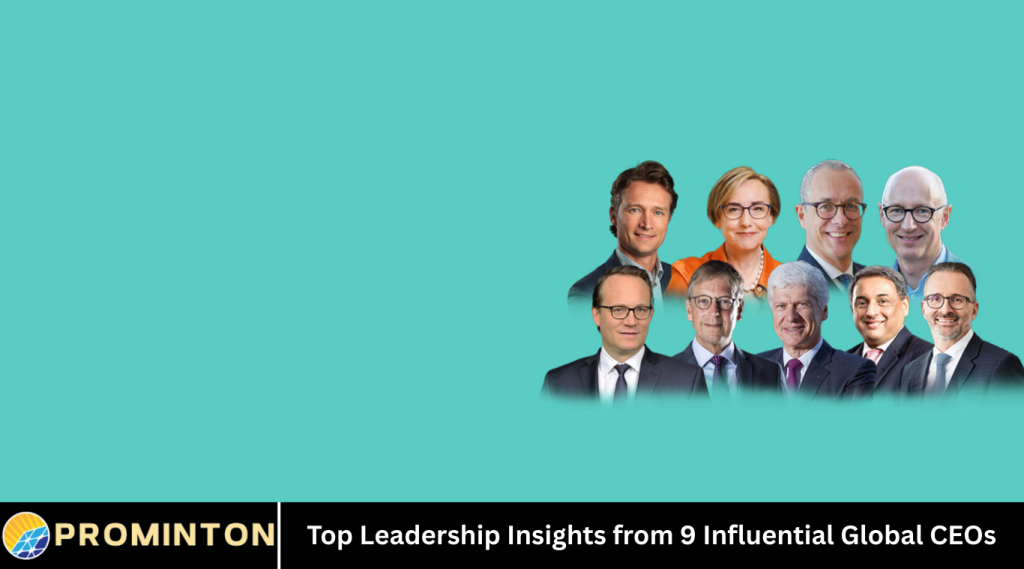Leadership is often the defining factor that determines a company’s success or failure. The ability to inspire teams, make tough decisions, and innovate continuously shapes the trajectory of organizations across industries.
Global CEOs, steering some of the world’s largest and most impactful companies, offer invaluable leadership lessons born from experience, vision, and resilience.In this article, we explore top leadership insights from nine influential global CEOs.
Each leader’s story provides unique perspectives and practical strategies that current and aspiring leaders can apply to grow their businesses and lead with purpose.
Satya Nadella – Microsoft
Key Insight: Empathy and Growth Mindset Drive Transformation
When Satya Nadella took over as Microsoft CEO in 2014, the company was seen as lagging behind in innovation. Nadella focused on transforming Microsoft’s culture by emphasizing empathy and a growth mindset.
- Empathy in Leadership: Nadella believes that understanding the perspectives of customers, employees, and partners is crucial. Empathy fuels innovation and collaboration.
- Growth Mindset: Inspired by psychologist Carol Dweck’s concept, Nadella encourages embracing challenges, learning from failures, and continuously improving.
- Cultural Shift: By shifting Microsoft’s culture toward inclusivity and openness, Nadella revitalized the company, driving cloud computing growth and new product lines.
Takeaway: Leading with empathy and fostering a growth mindset can transform organizations, making them more adaptable and innovative.
Mary Barra – General Motors (GM)
Key Insight: Leading Change with Courage and Accountability
Mary Barra is the first female CEO of a major global automaker, and her leadership during the company’s transition toward electric vehicles (EVs) and autonomous technology has been notable.
- Courage to Innovate: Barra embraced the challenges of shifting GM’s focus from traditional combustion engines to electric and self-driving cars.
- Accountability: She has been transparent about past mistakes, including recalls, and emphasized accountability at all levels.
- Customer-Centric Vision: Barra prioritizes delivering value to customers while addressing sustainability and safety concerns.
Takeaway: Courageous leadership combined with accountability helps navigate industries undergoing rapid technological change.
Sundar Pichai – Alphabet (Google)
Key Insight: Balancing Innovation with Responsibility
Sundar Pichai’s leadership at Google has involved balancing relentless innovation with ethical responsibilities.
- Innovate Relentlessly: Under Pichai, Google has expanded in AI, cloud computing, and hardware, maintaining its position as a tech leader.
- Ethical Leadership: Pichai has been vocal about the ethical implications of AI and data privacy, advocating for responsible tech development.
- Inclusive Culture: He promotes diversity and inclusion, understanding that innovation thrives in diverse teams.
Takeaway: Leadership today requires a balance between pushing innovation boundaries and upholding ethical standards.
Shantanu Narayen – Adobe
Key Insight: Customer-Centric Transformation and Digital Innovation
Shantanu Narayen led Adobe’s transformation from a software product company to a cloud-based subscription powerhouse.
- Focus on Customer Experience: Narayen prioritized delivering seamless customer experiences through digital tools.
- Agility: Adobe shifted to a subscription model with Adobe Creative Cloud, enabling continuous product updates and customer engagement.
- Empowering Teams: He fosters creativity and autonomy among employees to drive innovation.
Takeaway: Successful leadership embraces customer-centric innovation and adapts business models to evolving market needs.
Ginni Rometty – IBM (Former CEO)
Key Insight: Leading Through Digital Reinvention
Ginni Rometty guided IBM through a major reinvention focusing on cloud computing, AI, and data analytics.
- Visionary Leadership: She anticipated the digital transformation wave and invested heavily in emerging technologies.
- Collaboration: Rometty emphasized partnerships and ecosystem development.
- Resilience: Steering IBM through challenging periods required persistence and adaptability.
Takeaway: Vision and resilience are critical in leading legacy companies through digital disruption.
Elon Musk – Tesla and SpaceX
Key Insight: Bold Vision Coupled with Relentless Execution
Elon Musk is known for his audacious vision and ability to execute on seemingly impossible goals.
- Think Big: Musk tackles large-scale problems like sustainable energy and space exploration.
- Hands-On Leadership: He is deeply involved in technical and operational details.
- Risk Tolerance: Musk embraces risk and failure as part of the innovation process.
Takeaway: Bold visions combined with hands-on leadership and risk-taking drive breakthrough innovations.
Indra Nooyi – PepsiCo (Former CEO)
Key Insight: Strategic Long-Term Thinking and Purpose-Driven Leadership
Indra Nooyi transformed PepsiCo with a focus on sustainable growth and social responsibility.
- Purpose Beyond Profit: She integrated health, sustainability, and social issues into PepsiCo’s strategy.
- Long-Term Vision: Nooyi balanced short-term results with long-term brand building.
- Empowering Diversity: She championed inclusion and diversity within the company.
Takeaway: Purpose-driven leadership coupled with long-term strategic thinking builds enduring companies.
Jack Ma – Alibaba Group
Key Insight: Resilience, Adaptability, and Empowering Others
Jack Ma’s leadership took Alibaba from a small startup to a global e-commerce giant.
- Resilience: Ma’s journey included multiple failures and rejections before success.
- Adaptability: He continually evolved Alibaba’s business model to meet changing market demands.
- Empowering People: Ma believes in empowering employees and small businesses to succeed.
Takeaway: Resilience and adaptability, combined with empowering others, are key to entrepreneurial leadership.
Angela Ahrendts – Former Apple Retail Chief and Burberry CEO
Key Insight: Creating Emotional Connections and Transforming Customer Experience
Angela Ahrendts is known for her work in transforming retail at Burberry and Apple.
- Emotional Branding: She focuses on creating emotional connections between brands and customers.
- Experience-Driven: Ahrendts prioritizes customer experience across all touchpoints.
- Culture of Care: She promotes a caring culture within organizations.
Takeaway: Emotional intelligence and a focus on customer experience enhance brand loyalty and growth.
Common Leadership Themes from These CEOs
While each CEO has a unique style and operates in different industries, some common themes emerge:
- Empathy and Emotional Intelligence: Understanding people is fundamental.
- Vision and Innovation: Leaders must anticipate future trends and innovate.
- Resilience and Adaptability: The ability to navigate setbacks and change is essential.
- Customer-Centric Approach: Success depends on delivering exceptional value.
- Ethics and Responsibility: Leaders must balance ambition with integrity.
- Empowering Teams: Great leaders build strong, motivated teams.
- Purpose-Driven Leadership: Leading with a meaningful mission inspires loyalty and performance.
Frequently Asked Questions
How can I develop empathy as a leader?
Start by actively listening to your team, seeking feedback, and putting yourself in others’ shoes. Practicing emotional intelligence exercises helps build empathy over time.
What’s the best way to foster innovation in my organization?
Encourage experimentation, reward creative ideas, tolerate failure as a learning opportunity, and maintain open communication channels.
How do successful CEOs balance short-term pressures with long-term vision?
They set clear priorities, communicate their vision consistently, and make strategic investments while managing operational performance rigorously.
Can leadership skills be learned, or are they innate?
While some traits may be natural, most leadership skills can be developed through experience, training, mentorship, and self-reflection.
How important is company culture for leadership success?
Company culture profoundly impacts leadership effectiveness by influencing employee engagement, innovation, and overall performance.
What role does risk-taking play in leadership?
Calculated risk-taking drives growth and innovation. Successful leaders assess risks carefully but are not afraid to pursue bold ideas.
How can I inspire and motivate my team like these CEOs?
Lead by example, communicate a compelling vision, recognize achievements, foster collaboration, and support professional growth.
Conclusion
The leadership lessons from these nine influential global CEOs highlight the power of vision, empathy, resilience, and purpose. Whether you lead a startup or a multinational corporation, these insights can help you navigate challenges, inspire teams, and drive sustainable growth.
Great leaders don’t just manage—they transform organizations by connecting deeply with people and boldly shaping the future. By adopting these proven leadership practices, you can elevate your leadership impact and achieve remarkable results.



